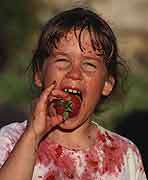Infants require different steps than older kids.
(HealthDay)—Choking is a leading cause of injury and death among American children, especially those age 3 years and younger, and parents and other caregivers need to know what to do in such cases, an expert says.
Food, toys and coins account for most choking incidents in young children, who put objects in their mouths as they explore their surroundings, according to the American Academy of Pediatrics.
"Should a child choke or swallow something dangerous, parents and caregivers may want to offer liquids and/or solids, but this is not recommended. Also, parents should not force the child to vomit. Have the child see the doctor as soon as possible or take the child to the emergency room," Dr. Grace Arteaga, a pediatrician at the Mayo Clinic Children's Center in Rochester, Minn., said in a Mayo news release.
If a child is coughing forcefully after swallowing an object, encourage him or her to continue coughing and do not interfere. But if the swallowed object blocks the airway and the child can no longer cough and breathing becomes more difficult, parents and caregivers should use the "five-and-five" approach to choking first aid:
- First, give five back blows between the child's shoulder blades with the heel of your hand.
- Next, give five abdominal thrusts (also known as the Heimlich maneuver). For infants, use chest compressions because abdominal thrusts may cause injury.
- Alternate between five back blows and five abdominal thrusts/chest compressions until the blockage in the throat is dislodged. At the same time, someone needs to call for emergency assistance.
The advice for choking infants is different. Hold the infant facedown on your forearm. The infant's head should be lower than his or her body. Thump the infant firmly on the middle of the back using the heel of your other hand, Arteaga said. The combination of gravity and force from the hand thumps should dislodge the object blocking the infant's airway.
Arteaga advised against the use of a finger sweep, which could lodge the object farther down the infant's airway.
More information: The American Academy of Pediatrics offers choking prevention tips.
Copyright © 2013 HealthDay. All rights reserved.




















